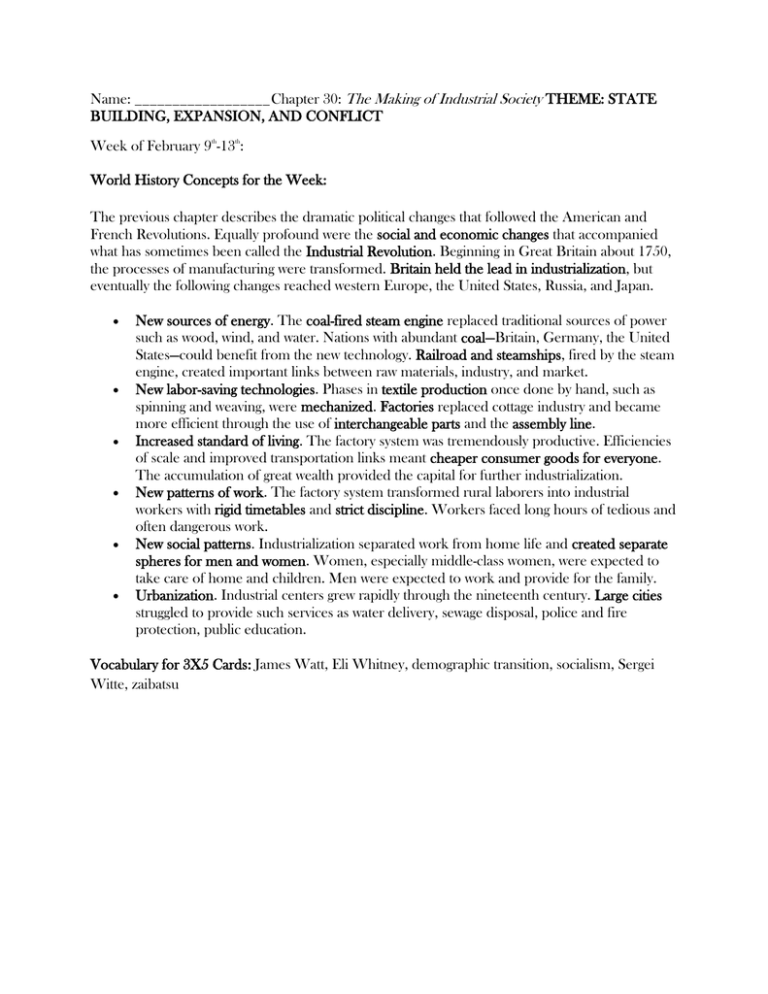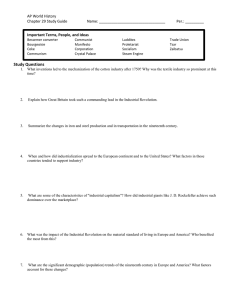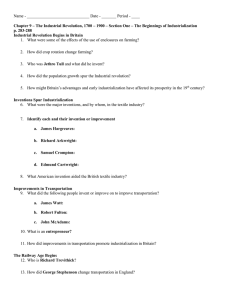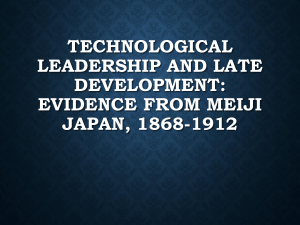
Name: __________________ Chapter 30: The Making of Industrial Society THEME: STATE
BUILDING, EXPANSION, AND CONFLICT
Week of February 9th-13th:
World History Concepts for the Week:
The previous chapter describes the dramatic political changes that followed the American and
French Revolutions. Equally profound were the social and economic changes that accompanied
what has sometimes been called the Industrial Revolution. Beginning in Great Britain about 1750,
the processes of manufacturing were transformed. Britain held the lead in industrialization, but
eventually the following changes reached western Europe, the United States, Russia, and Japan.
New sources of energy. The coal-fired steam engine replaced traditional sources of power
such as wood, wind, and water. Nations with abundant coal—Britain, Germany, the United
States—could benefit from the new technology. Railroad and steamships, fired by the steam
engine, created important links between raw materials, industry, and market.
New labor-saving technologies. Phases in textile production once done by hand, such as
spinning and weaving, were mechanized. Factories replaced cottage industry and became
more efficient through the use of interchangeable parts and the assembly line.
Increased standard of living. The factory system was tremendously productive. Efficiencies
of scale and improved transportation links meant cheaper consumer goods for everyone.
The accumulation of great wealth provided the capital for further industrialization.
New patterns of work. The factory system transformed rural laborers into industrial
workers with rigid timetables and strict discipline. Workers faced long hours of tedious and
often dangerous work.
New social patterns. Industrialization separated work from home life and created separate
spheres for men and women. Women, especially middle-class women, were expected to
take care of home and children. Men were expected to work and provide for the family.
Urbanization. Industrial centers grew rapidly through the nineteenth century. Large cities
struggled to provide such services as water delivery, sewage disposal, police and fire
protection, public education.
Vocabulary for 3X5 Cards: James Watt, Eli Whitney, demographic transition, socialism, Sergei
Witte, zaibatsu
Monday, February 9th: Introduction to chapter, examining distal and proximal causes within
Industrialization.
HW: Pages 815-825, answer the following questions using complete sentences:
1) Explain how Great Britain took such a commanding lead in the Industrial Revolution.
Write a claim that could be used to kick off this prompt. (Use and underline the
following terms in your answer: James Watt)
2) Summarize the changes in iron and steel production and in transportation in the
nineteenth century. Which do you think was the most significant? Why?
3) When and how did industrialization spread to the European continent and to the
United States? What factors in those countries tended to support industry? (Use and
underline the following terms in your answer: Eli Whitney)
4) What are some of the characteristics of “industrial capitalism”? How did industrial
giants like J.D. Rockefeller achieve such dominance over the marketplace?
Tuesday, February 10th: Examining Malthus and his theories on population (BRING BOOKS!)
HW: Pages 825-836:
5) What was the impact of the Industrial Revolution on the material standard of living in
Europe and America? Who benefitted most from this?(Use and underline the
following terms in your answer: demographic transition)
6) What are some of the significant demographic trends of the nineteenth century in
Europe and America? What factors account for these changes? Also consider the
impact on working-class families.
7) In what ways did the major industrial nations of the west become more responsive to
the needs and interests of working people? (Use and underline the following terms in
your answer: socialism)
Wednesday, February 11th (periods 3 and 5), Thursday, February 12th (period 4): Structured
Academic Controversy: Did the Industrial Revolution lead to a Sexual Revolution? (in class)
HW: Pgs. 836-842,
8) Compare the process of industrialization in Russia and Japan in the late nineteenth
century. (Use and underline the following terms in your answer: Sergei Witte, zaibatsu)
9) What was the impact of Western industrialism on the nonindustrial countries of Asia
and South America?
Friday, February 13th: Homework and study cards due (star which answer you want me to focus on),
Short answer quiz.






